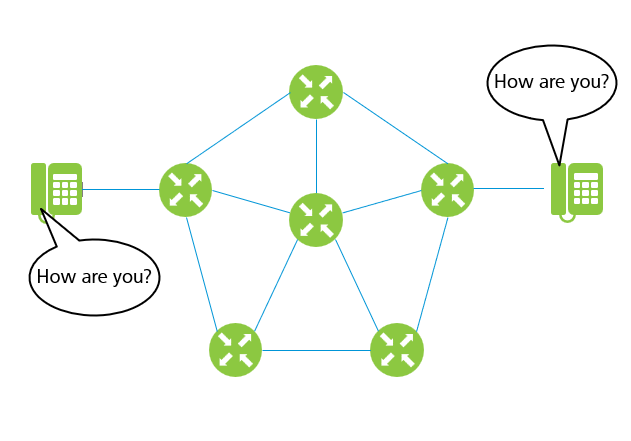VoIP monitoring needs dual visibility to truly understand the quality of a voice call. We’re not talking about seeing double; we’re talking about looking at both control and media planes.
VoIP analytics usually overemphasize SIP signaling and call connectivity – the control plane. It focuses on metrics that characterize whether the call was established and maintained with less attention given to the media delivered and the in-call quality provided.
But consider ordering a product online. The minimum expectation is that something will arrive at your house. Whether the product is any good is a separate and perhaps more important question to answer. This is precisely what dual visibility and monitoring the media plane allows you to do: Ensure calls are connected and are of high quality.
With dual visibility, looking at both SIP signaling and RTP media control, you see the full picture when it comes to VoIP. Instead of only looking in one direction, dual visibility goes beyond call connectivity to provide a 360o view of what is actually being delivered.

At Voipfuture, we believe in slicing things up and breaking them down (check out our unique RTP time-slicing technology). So, let’s break down dual visibility and look into what it means for assessing voice services.
Circuit switching vs. packet switching, and the need for monitoring RTP media
First, a little telephony history to understand why the industry struggles to monitor and measure RTP media transmission.
Traditional telephony converts audio into electrical signals and transmits them between parties using circuit switching. This creates a real and physical copper path between endpoints in a vast network. Once that path is established, there is little that can go wrong. The electrical signals are transferred back and forth and converted into audio at either end.

The rise of IP completely changed this paradigm. Instead of establishing a permanent physical connection between parties, data is separated and sent in small chunks or packets. We call this packet switching, and each packet makes its way across the network to (hopefully) end up with the intended recipient.
While Voice over IP offers a range of advantages from cost savings to flexibility and scalability, it also adds considerable complexity. Sharing one network with different services and sending each 20ms audio packet of a call separately leaves more room for error.
Because telephony is rooted in circuit switching, there remains a focus on the measurements and KPIs that only characterize the control plane. The most crucial factor for a circuit switching network is call connectivity and establishing a physical path between users. For packet switching, you also need to monitor the media plane to ensure the packets are arriving as expected and the resulting in-call quality is up to standard.
While VoIP is the standard now, traditional telephony technology has decades of usage and understanding. Therefore ITU, ETSI, IETF, 3GPP, and other standards organizations have series of well-defined KPIs focusing on the control plane and SIP signaling.
The legacy of circuit switching affects the whole industry. When we receive an RFQ, there are dozens of signaling KPIs and measurements to consider, and very few that define the media plane – MOS, jitter, packet loss, and delay; that’s about it.
But we shouldn’t let history hold us back from measuring the actual quality of modern voice services and designing effective VoIP monitoring KPIs. That implies not turning a blind eye on media monitoring. Dual visibility allows us to better understand both call connectivity and in-call quality, as well as the real end-user experience.
Call connectivity: a VoIP monitoring fundamental everyone agrees on
All this isn’t to diminish SIP monitoring. While RTP media monitoring needs improving to match the realities of packet switching, understanding the control plane will always be fundamental to VoIP monitoring. Thankfully, dual visibility illuminates both.
SIP, or Session Initiation Protocol, is the internet’s standard for establishing and managing generic “sessions” – telephony is only one possible application. Here, the protocol connects call parties over the internet, removing the need for a dedicated network, such as ISDN. Along with other vital protocols, SIP governs the establishment and termination of a VoIP call, collectively referred to as the control plane.
Among the relevant SIP signaling information to track are:
- Calling and called party number
- Call setup time
- Post-dial delay
- Call states
- Hang-up causes
Proactively monitoring SIP signaling data leads to successful and seamless call setup and simplified troubleshooting. Probing the control plane allows you to:
- Identify any root cause for SIP signaling problems.
- Gather real-time VoIP traffic data.
- Generate alerts if connectivity issues occur.
You want accurate Call Detail Records (CDRs) to provide an end-to-end summary of a call and all the information gathered. Aggregating CDRs creates SIP signaling KPIs that allow to assess the signaling performance of different sets of calls.
Why in-call experience and RTP media monitoring is just as important
Transporting many packets separately across a network means media quality can vary. There are just too many network elements involved to ensure consistently outstanding performance for millions of packets a second.

All RTP media packets need to be monitored from start to finish with a high temporal resolution to maintain in-call quality. This way, you can identify fluctuations and better understand the performance of your voice services.
RTP, or Real-time Transport Protocol, is what delivers the audio over the internet. If you think of SIP as the protocol that creates the connections across the internet, RTP is what transports the media across these connections.
An example of a problem that requires RTP media monitoring is a silent call. The call is established, but both parties can’t hear one another. The root cause could be that the RTP packets are sent, but don’t arrive at the receiver. However, probes assessing the RTP media stream allow you to see where the data is lost and learn the cause of the problem. One possibility is that perhaps the route is longer than the default TTL (Time to live), and the router is discarding packets when TTL = 0.
Without VoIP monitoring that also considers RTP media transport, this problem can go unnoticed. You need dual visibility to prevent call connectivity tunnel vision and bring the complete VoIP picture into view.
Dual visibility: more than the sum of its parts
SIP signaling alone doesn’t offer the insights you need to assess VoIP services. To see everything you need means to monitor both the control plane (call connectivity) and the media plane (in-call quality).
- SIP signaling lets you see the big picture – the call was established.
- RTP media control lets you zoom in on the details – the quality of the media being delivered.
Dual visibility – combining the two – gives you a complete view of the voice services you offer and how the customer experiences them. Plus, dual visibility is greater than the sum of its parts. Correlating data from both planes makes it easier to spot issues, compounding the benefits of each.
At Voipfuture, we take pride in our dual visibility technology. Check out our recent Qrystal 8 release. With extended dual visibility capabilities, we now provide an enhanced control plane monitor complementing the Voipfuture RTP indicators.


